
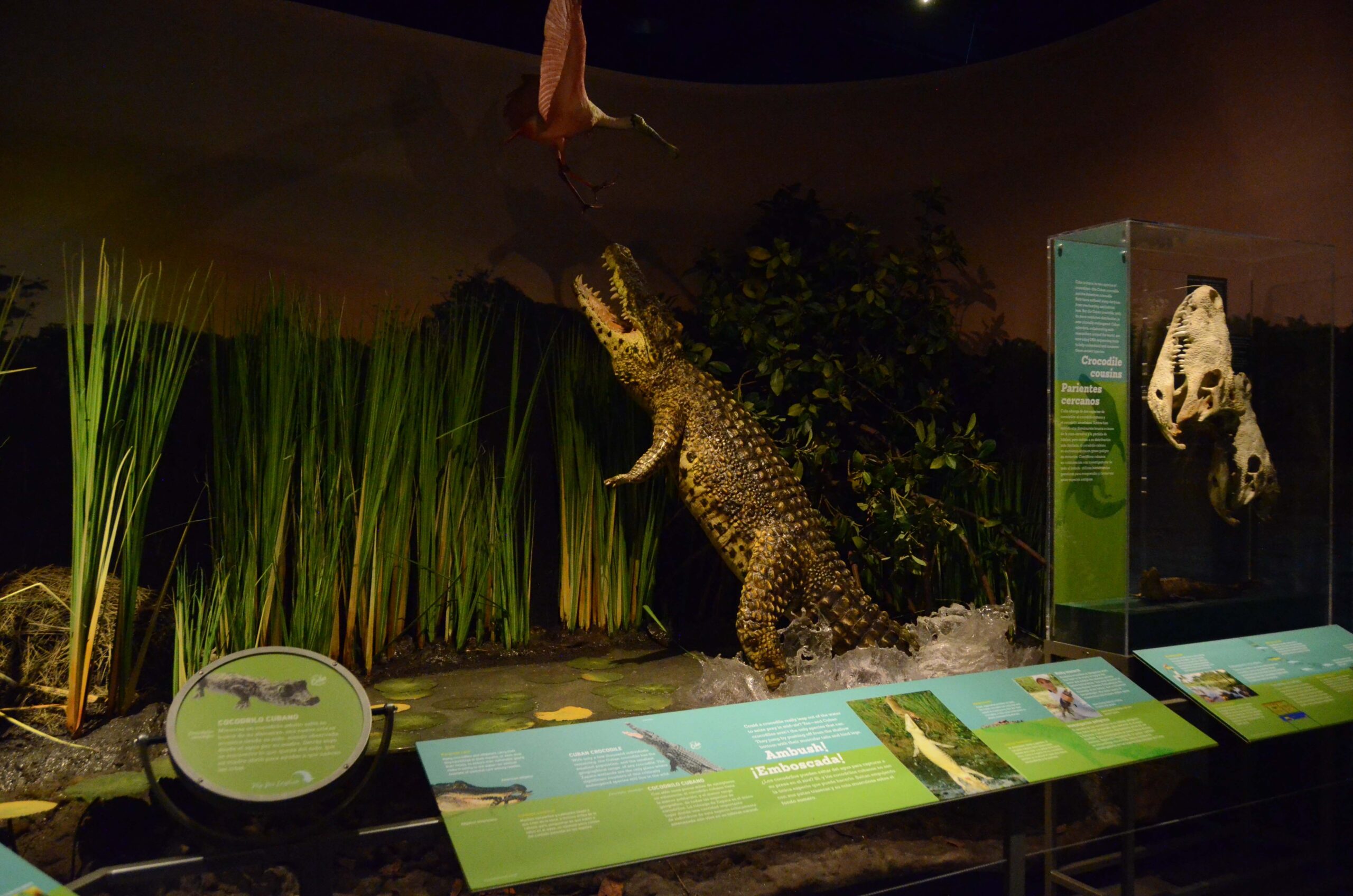
Cuba is a place of exceptional biodiversity and cultural richness, and now a new bilingual exhibition at the Exploreum will offer visitors fresh insights into this island nation just 94 miles from Florida’s shores. With a close look at Cuba’s unique natural history, including its native species, highly diverse ecosystems, and geology, ¡Cuba! also explores Cuba’s history, traditions, and contemporary Cuban voices to inspire novel perspectives on this dynamic country. Organized by the American Museum of Natural History in New York, ¡Cuba! will be on view starting Spring 2024.
Technically an archipelago of more than 4,000 islands and keys, Cuba is the largest island nation in the Caribbean—and one of the region’s most ecologically diverse countries. About 50 percent of its plants and 32 percent of its vertebrate animals are endemic, meaning they are found only on the island. The exhibition will include live animals, specimens, and lifelike models representing the island’s distinctive wildlife, from a venomous mammal to the world’s smallest bird. Biodiversity displays were developed by the American Museum of Natural History in close collaboration with scientists at the Cuban National Museum of Natural History (Museo Nacional de Historia Natural de Cuba, MNHN). Highlights include a re-creation of the Zapata wetlands, home to the endangered Cuban crocodile, and a reconstructed cave environment.
Title Sponsor: City of Mobile
Premier Sponsor: Sweet Home Alabama
Major Partners: Mobile County – District 2 & Austal USA
Media Sponsor: WKRG-TV5
Hotel Sponsor: Renaissance Riverview Plaza Hotel
Educational Sponsor: University of South Alabama’s Stokes School of Marine and Environmental Sciences
Additional Sponsors/Partners: Alabama Power, Spire Energy, Blue Cross And Blue Shield of Alabama, Mobile County Marketing Fund, Las Floriditas, Mobile Ballet
EDUCATOR’S RESOURCES
¡Cuba! Visitor’s Guide (English)
¡Cuba! Visitor’s Guide (Spanish)
Additional Resources via AMNH can be found here including English and Spanish reading guides and more. CLICK HERE.
More resources coming soon so check back periodically.
For field trips and group booking inquiries please contact:
Monica Dunklin
1-251-208-6880
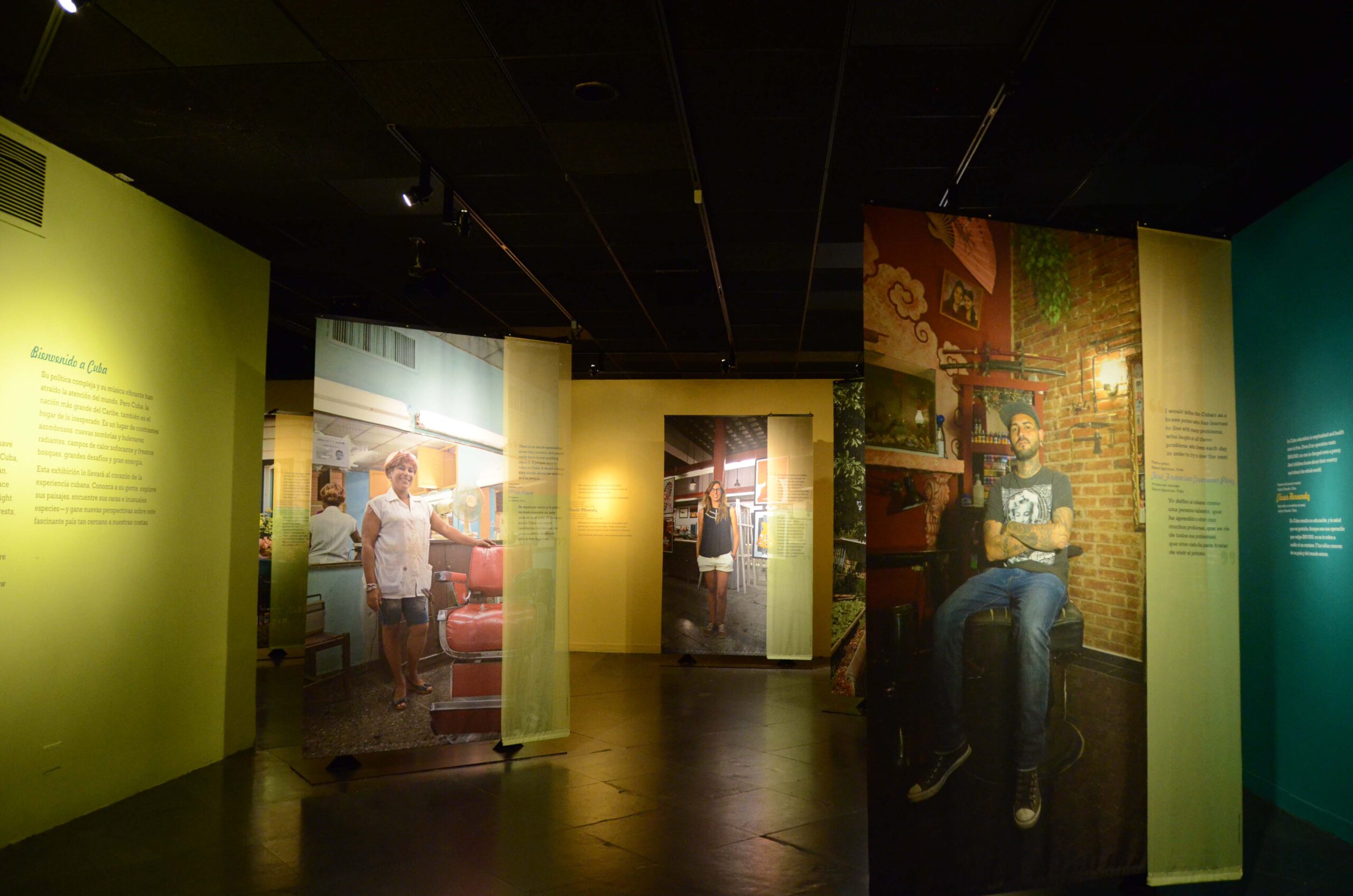
The exhibition opens with life-sized portraits of modern Cubans paired with short excerpts from interviews, offering a chorus of voices—from Cuba and abroad, young and old, urban and rural, pragmatic and optimistic. A long, open boulevard evoking the street life one might find in a Cuban city will invite visitors to discover Cuban culture through music, games, and a variety of interactive experiences. Other highlights include a pair of altars celebrating orisha religion, an Afro-Cuban spiritual tradition also known as Santeria; a gallery showcasing contemporary Cuban art; and a display on the cultivation of one of Cuba’s most famous crops, tobacco. An introductory film about Cuba’s history—including its first peoples, slavery, sugar industry, and the 1959 revolution—will provide visitors with historical context for contemporary realities.
The American Museum of Natural History has long collaborated with Cuban scientists at a number of institutions, including the MNHN, the University of Havana, the Cuban Botanical Society, and the National Enterprise for the Protection of Flora and Fauna. Museum scientists have led and participated in nearly 30 expeditions and field projects to Cuba for more than 125 years.
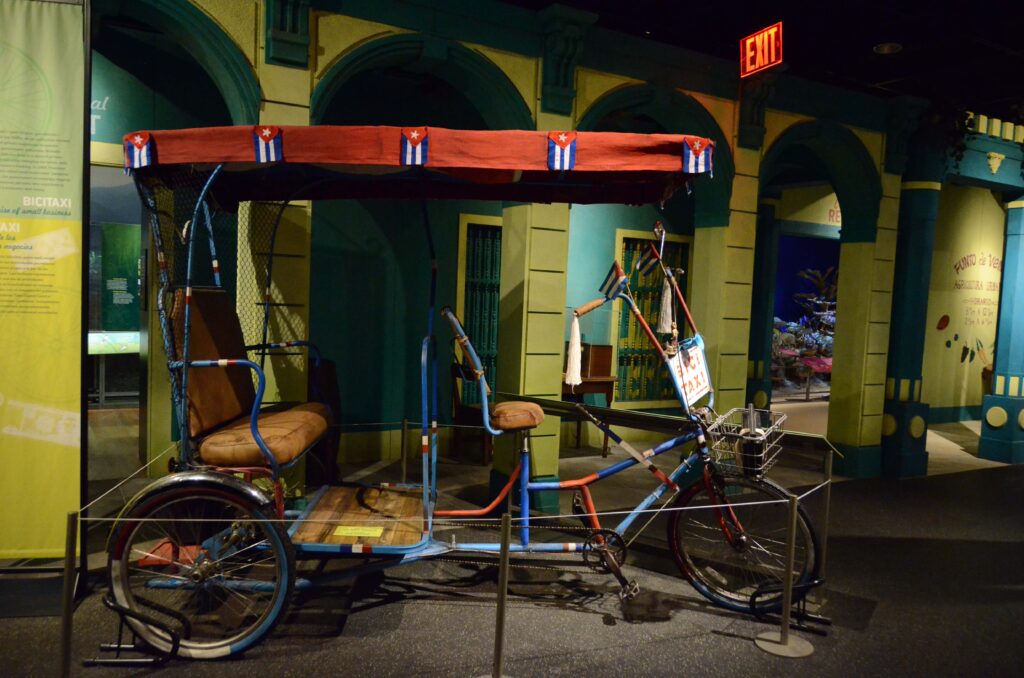
Building on this long legacy, the American Museum of Natural History launched a research collaboration with Cuba under the banner of Explore21—a comprehensive Museum initiative that began in 2013 to foster a series of innovative scientific expeditions to meet the challenges and opportunities of the 21st century. In the fall of 2015, the Explore21 Expedition to Cuba sent a team of Museum and Cuban scientists to Alejandro de Humboldt National Park, one of the most remote and biologically important areas of the country, to advance the understanding of Cuban biodiversity, its evolution, biogeography, and conservation. ¡Cuba! will feature footage from the expedition’s survey.
The U.S. and Cuba share ecosystems and biodiversity, and face shared environmental challenges. For example, Cuba, which is located just 94 miles south of Florida, provides important wintering habitats for more than 280 bird species that breed in the United States. The two countries share 49 animal species and eight plant species that are characterized as “globally threatened” by the International Union for the Conservation of Nature and Natural Resources. And invasive species, like the red lionfish, prey on the native fish and disrupt ecosystems ranging from waters off of North Carolina all the way down to the Caribbean.
“We share environments and environmental interests,” said ¡Cuba! co-curator Ana Luz Porzecanski, director of the American Museum of Natural History’s Center for Biodiversity and Conservation. “Cuba’s nature has been protected both because of historical circumstance and because Cubans themselves have been very committed to protecting their biodiversity. Collaborations in education and research are critical, as they underpin conservation efforts and shape a sustainable vision of the future.”
¡Cuba! will look at the environmental challenges the country faces, as well as the many effective conservation laws and measures in place to preserve its unique landscape. As the political and economic relationship between the U.S. and Cuba continues to evolve, the exhibition aims to promote visitor understanding of Cuba’s history as well as its future.
“We really want to surprise visitors with details about Cuba that they’ve never thought about before,” said ¡Cuba! co-curator Chris Raxworthy, curator-in-charge of the American Museum of Natural History’s Department of Herpetology. “We hope this exhibition relays an understanding of who the people of Cuba are, how the island nation is biologically unique, how it is connected to the world, and what it’s like to live in Cuba now.”
A Stroll in the City: Cuba’s city streets have been shaped by the country’s history as a Spanish colony and by the enormous wealth created by the sugar industry beginning in the early 1800s. In Havana, Cienfuegos, Camagüey, and many other Cuban cities, stately plazas and grand boulevards are lined with colonnades—covered walkways with graceful arches and columns inspired by Renaissance Europe and ancient Greece and Rome. These airy, multicolored arcades offer protection from the elements as well as open space for community life. The ¡Cuba! exhibition features a long, open city boulevard emulating a street you might find in Cuba. Tables lining the exhibition’s street encourage visitors to try their hand at Cuban dominoes, which, unlike American dominoes, have tiles with up to nine dots; enjoy the aroma of a cup of Cuban coffee, called a cafecito; listen to music you might find on a Cuban radio station today, ranging from classical to rock; and check out Cuba’s 16 baseball teams.
A 1955 Chevrolet Bel Air reveals the story behind the vintage cars that famously rumble down Cuban streets. From 1959 until recently, the Cuban state tightly restricted car imports and sales. At the same time, the United States’ embargo banned most exports to Cuba, including car parts, so Cubans have found ingenious ways to keep old cars running, despite a shortage of spare parts.
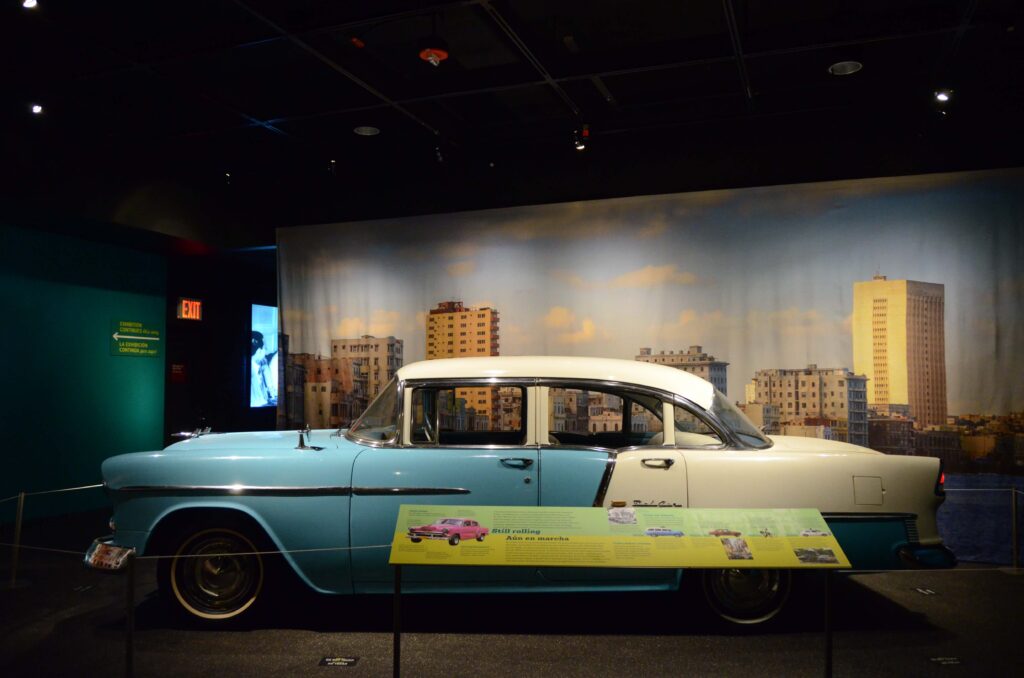
Nature: ¡Cuba! explores the extraordinary biodiversity found in the island’s remote forests, mysterious caves, expansive wetlands, and dazzling reefs through immersive exhibits that developed by the American Museum of Natural History with colleagues at MNHN.
The mountainous area of eastern Cuba that includes Alejandro de Humboldt National Park (named for Prussian naturalist Alexander von Humboldt) is among the most biologically diverse island sites on the planet—and is now carefully protected. In the exhibition, visitors will learn about some of the rare animals that live there: the mammal Solenodon cubanus, known in Cuba as the almiquí, which secretes venomous saliva through a groove in its front teeth and was once thought extinct, and the bee hummingbird (Mellisuga helenae), which at about 1/20th of an ounce is the smallest bird in the world—smaller than many bees. Visitors also will see species of live reptiles and amphibians, including the Cuban boa (Chilabothrus angulifer), the Cuban tree frog (Osteopilus septentrionalis), which produces toxic mucus that irritates people’s eyes, and six different species of tree-dwelling lizards called anoles.
Cuba is pitted with caves, created over millions of years as water dissolved underground limestone. Hidden from view, shielded from the elements, caves harbor tantalizing traces of Cuba’s past. Although the written record of Cuba’s people begins in 1492, its caves reveal evidence of a human prehistory thousands of years long. Based on artifacts preserved in those caves, scientists have evidence that people came to the island in a number of waves starting 6,000 or more years ago and may have had their origins in Central America, in South America, or even North America. Cave deposits also reveal that Cuba once had its own unique set of land animals, many of which are now extinct, including an extinct giant owl, Ornimegalonyx, the largest owl that ever lived. The exhibition features a life-sized model of this 39-inch-tall bird. A variety of interactive exhibits—including one that explores landmass changes and sea-level rise over deep time and a “hidden animals” game that invites players to search for Cuban wildlife in its natural habitat—lets visitors discover more about Cuba’s geology and biodiversity.
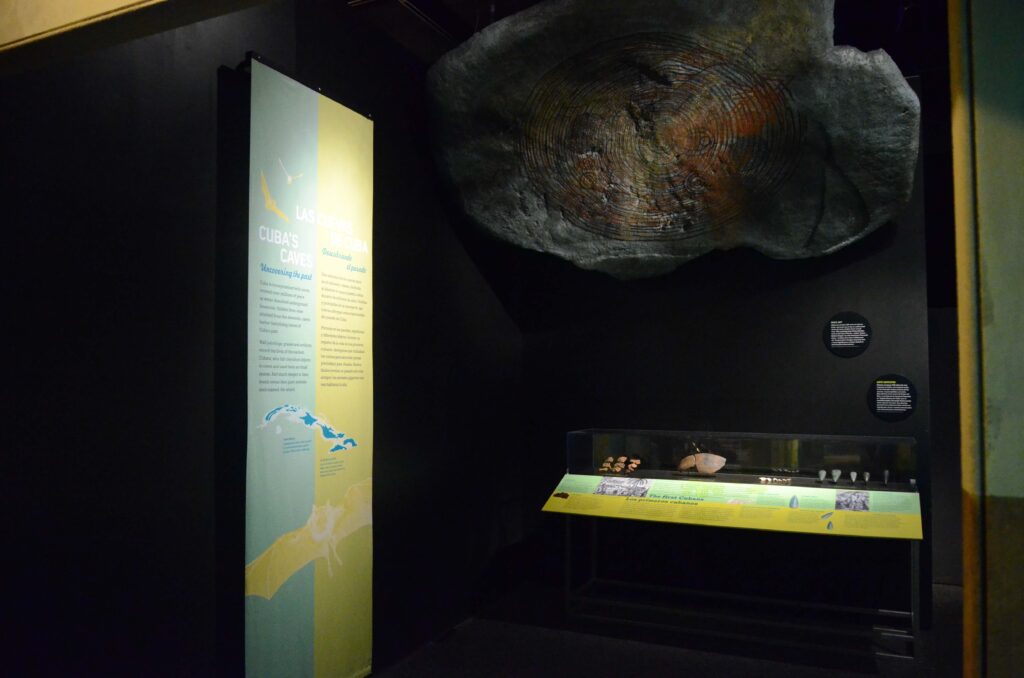
On the southwest side of Cuba, the Zapata peninsula contains the largest and most important wetlands in the Caribbean. Covering 1.5 million acres, the immense Zapata Biosphere Reserve includes marshes, peat bogs, mangroves, coral reefs, and forests that support a complex web of life, including frogs, turtles, fish, shellfish, birds, and countless plants and insects, making its conservation a top priority for the entire region. An immersive walk-through reconstruction of this reserve will introduce the exhibition’s visitors to these animals, including the two species of crocodiles that live in Cuba: the Cuban crocodile (Crocodylus rhombifer) and the American crocodile (Crocodylus acutus). Both have suffered steep declines from overhunting and habitat loss. But with only a few thousand individuals remaining, the Cuban crocodile has the smallest population, and the smallest geographical range, of any crocodile. The Zapata wetlands are the only place where significant numbers of this critically endangered species still live in the wild. Since 1999, a team of U.S. and Cuban scientists led by George Amato, director of the Sackler Institute for Comparative Genomics at the American Museum of Natural History, have been working in Zapata and Wildlife Refuge Monte Cabaniguán on a long-term study of the evolution and conservation of the two crocodile species.
Not far from the main island of Cuba, along a string of jewel-like keys called Gardens of the Queen, silvery fish zip past banks of coral studded with colorful starfish, sea fans, and sponges. To protect this vital diversity, Cuba has created the largest marine reserve in the Caribbean. Coral reefs are some of the richest ecosystems on Earth, and on many Caribbean coastlines, they are in danger of disappearing. But in this protected area in Cuba, the reef is wonderfully alive. An open coral reef diorama in ¡Cuba! showcases some of that life, including hawksbill turtles (Eretmochelys imbricata), which nest on beaches in Gardens of the Queen, and spotted eagle rays (Aetobatus narinari), which move between Cuba and the coasts of Florida and Mexico.
Culture: Cuba is home to more than 11 million people, who can trace their ancestry to indigenous people, Spanish colonists, African slaves, and immigrants from the Philippines, China, Europe, the Canary Islands, Jamaica and Haiti. A wide variety of religious traditions coexist in Cuba, and in recent decades, their role in Cuban society has grown. In the early years of the Cuban Revolution, the government declared Cuba an atheist state and suppressed organized religion. But new constitutions in 1976 and especially 1992 recognize the right to religious freedom. Today, many churches and temples in Cuba maintain strong ties with congregations in the United States and other countries. Cubans from many different walks of life find inspiration in orisha religion, a spiritual practice with West African roots often called Regla de Ocha, or Santería. Those who follow this path seek guidance from orishas, sacred beings who reign over human endeavors and the forces of nature. Ceremonies take place inside a home, rather than a public temple or church. To honor the orishas, practitioners sometimes create elaborate altars or “thrones”—sacred spaces that present these powerful beings in regal splendor. Two such thrones were created especially for display in the exhibition.
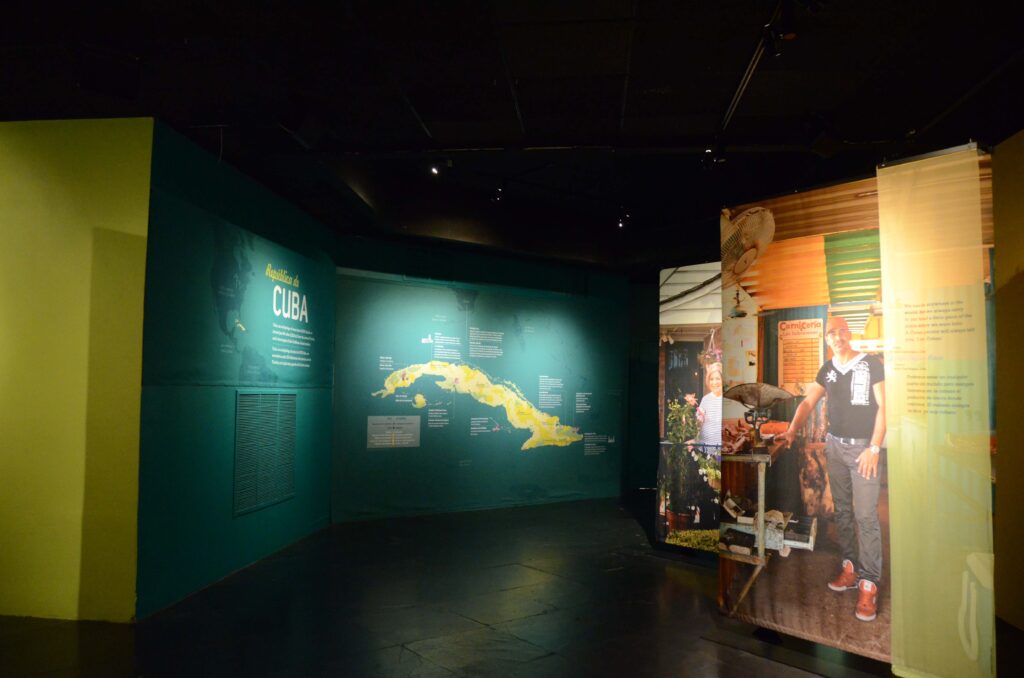
When Spanish sailors first explored Cuba in 1492, they returned with accounts of tall forests, chattering birds, and men and women going from place to place “with a firebrand of weeds in their hands to take in the fragrant smoke.” Before long, Spanish colonists were growing and smoking tobacco, too. As the demand for tobacco spread, the “weeds” became a profitable crop, powered by the labor of African slaves who also made possible the lucrative trade in coffee and especially sugar. Cuba opened its first cigar factories in the early 1800s. Today, cigars are still one of Cuba’s leading exports, with around 100 million handcrafted and shipped around the world every year. To plant, tend, and prepare fine tobacco for Cuban cigars, farmers use exacting methods passed down over generations. Working meticulously, they pick leaves one by one, string them along wooden poles, and hang them in sheds with vents that can open and close to control temperature and humidity. Visitors can see a replica of one of these sheds in the exhibition. Over weeks, the leaves cure, losing water and turning from bright green to soft brown. Professional rollers called torcedores make each cigar by combining leaves from different varieties of tobacco. Cigars are sorted by color, checked for flaws, and then boxed for sale.
Perhaps best known as the birthplace of rhythmic dances like the mambo and the cha-cha, Cuba is also home to a rich ballet tradition and film making—and a broader art scene that is dynamic and constantly evolving. The Cuban government has supported the arts through specialized schools, galleries, concert halls and many other cultural institutions and programs, but it has also limited some artistic expression. Since the 1990s, reforms have allowed artists to travel abroad and sell their work more freely, and today, many Cuban artists collaborate with artists outside Cuba and display or perform their work on the global stage. In ¡Cuba! visitors will see a large collection of original posters created in the last decade by a new generation of Cuban artists. Most of the artworks on display were commissioned by government-run cultural institutions to advertise plays, films, festivals, and concerts, but recent years have also seen a blossoming of art and design as an autonomous and independent enterprise. The exhibition also includes an interactive art “gallery”—a room where visitors can choose paintings, sculptures, or performance art created by Cuban artists to be projected on the walls.
¡Cuba! is organized by the American Museum of Natural History, New York (amnh.org) in collaboration with the Cuban National Museum of Natural History.
About the American Museum of Natural History (amnh.org)
The American Museum of Natural History, founded in 1869, is one of the world’s preeminent scientific, educational, and cultural institutions. The Museum encompasses more than 40 permanent exhibition halls, including the Allison and Roberto Mignone Halls of Gems and Minerals which opened in 2021 – and those in the Rose Center for Earth and Space and the Hayden Planetarium, as well as galleries for temporary exhibitions. It is home to New York State’s official memorial to Theodore Roosevelt, a tribute to Roosevelt’s enduring legacy of environmental conservation. The Museum’s scientists draw on a world-class research collection of more than 34 million artifacts and specimens, some of which are billions of years old, and on one of the largest natural history libraries in the world. Through its Richard Gilder Graduate School, the Museum grants the Ph.D. degree in Comparative Biology and the Master of Arts in Teaching (MAT) degree, the only such free-standing, degree-granting programs at any museum in the United States. The Museum’s website, digital videos, and apps for mobile devices bring its collections, exhibitions, and educational programs to millions more around the world. Visit amnh.org for more information.
EDUCATOR’S RESOURCES
¡Cuba! Visitor’s Guide (English)
¡Cuba! Visitor’s Guide (Spanish)
Additional Resources via AMNH can be found here including English and Spanish reading guides and more. CLICK HERE.
More resources coming soon so check back periodically.
CUBA tells the powerful story of a land preserved in time, yet poised on the cusp of dramatic change. The nation’s vibrant culture, meticulously maintained colonial architecture, and pristine ecosystems provide a vivid window into the island’s history and spirit. CUBA will transport audiences across breathtaking landscapes, under the ocean surface to iridescent reefs, and into streets throbbing with music and dance in the heart of Havana. Through the eyes of Cuban artists, historians, and scientists, the film provides an intimate look this vivacious island nation. Filmed exclusively for giant screen formats, CUBA reveals why Cuba continues to stir the imagination of the world. CUBA is produced by Golden Gate 3D, in association with BBC Earth, Giant Screen Films and the Giant Dome Theater Consortium.
Notifications